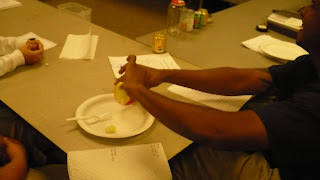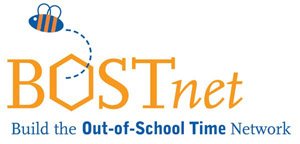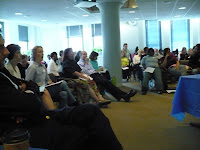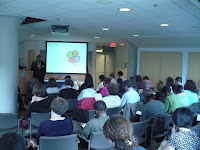
Project-based learning has been around for a long time. Many of the early progressive educators were indeed doing projects. The educational philosopher
John Dewey was looking to make learning more real than the factory-style learning he saw about him. In the decades since, there has been innovation in teaching and learning inside and outside of the classroom.
Today, there are student centered classrooms, reading corners, rocking chairs, and carpet areas and many other innovative strategies and frameworks being used inside the school day. There is still a great deal of traditional structure and those who see a further erosion of free time, recreation, and creative problem solving in the school day. There is a great deal of pressure on schools. They are asked to carry many of the traditional roles assigned to parents, and yet, teach a specific body of information and create a common culture. With schools mandated to have delivered outcomes for every hour of the day, cannot out-of-school programs assist by creating a different learning environment not to augment the school-day tasks, or in opposition to the learning styles of traditional education, but to create that social-emotional playground where children and youth can learn by hands-on activities and the socialization that contextualizes all understanding?
Project-based learning in out-of-school is not just about dissecting eels, improving the process of making clay dough, or creating a model of the neighborhood to understand the importance of places, it is also about the process. A time to see what others know, understand how actions impact the group as well as to take individual initiative. The papier-Mâché float, or the community map, or the fundraiser run by the children and youth is not always the largest, or finished on time, or as grand as the original plans, and the outcomes cannot always fit the metrics of the school day. Nevertheless, when the framework is clear, when adult staff are energized about leading projects that dig into a topic over roughly connected activities (theme activities, arts and crafts without context, etc) there is a learning environment that can reach out to children and youth and really dig into the benefits of out-of-school time as a place of social contact and deeper learning.
At a recent training, a group of group leaders were learning how to become project specialist. Being a project specialist means not just leading fun activities, but sequencing activities to answer or explore big questions and fun and engaging topics. The group was led on a simple activity. Make pasta drawings. Everyone seems to have remembered what this meant. Some asked questions about whether they could draw lines first, plan, or what the picture was to be about. They were told that they could do this activity any way they wanted. They were even provided tooth picks to add into their pasta drawings if they wanted. After a short period of time, the group was gathered together. They were told to get up and look at other tables, look at other works, and if need be, make constructive comments. When they were sitting, the group was asked - was this a project.
The unanimous opinion was "yes." It was hands-on, it was an open ended activity, they shared the materials and showed each other what they made. However, what was the deeper learning? "We learned to work together" one staff member said. However, did they now know that before the start of the activity? It may be that it reinforced what they knew, which is not a bad thing, but what new learning did it lead to? Also, did the product they made matter. "No. I'm going to throw it out as soon as we leave." This is similar to how many children respond to the things they are asked to make in out-of-school. The "done and dump" outcome.
The group was then led through what project elements were in the activity but how that activity did not reach as far as we can go in out-of-school - even though it was a fun activity in-of-itself.
The day before at the training one project example given was zombies.
Yes, zombies.
The group revisited that topic - used as a comical example that this group of adult learners - because it spoke to them. "Zombies" then became the focus of our project simulation, even if it was not a child-ready topic. It was engaging for the adults, therefore, they could better see the process and experience some of that fun in learning and exploring we hope children and youth will engage in but which many staff cannot find then discussing clay modeling as if they were themselves children. The group discussed what they would make in a zombie project.

The title selected was "Zombie Attack." The final product an escape plan. The group talked and discussed what they needed to learn. "What do zombies eat," "why are they here," "are they fast or slow." The group put down some of those questions as well as "how do we work together" an then looked at the project. The group made a list of things they could do as activities as well as resources. When this was done, they again looked at the learning goals. Were some of those questions short-lived or limited? They asked larger questions which would naturally capture smaller fact-based questions. "What do we need to know about zombies?" was the first learning goal, collecting the other zombie fact questions into one bucket. The next was "what do we need to survive?" This question is not just about zombies, but can be taken as "what do we bring" or at a deeper level "what are the basics of life or things that are important to us?" The Third question was "how do we make a plan?" This came up because the group was divided between where to go (Home Depot or Walmart) and how to get there (run as a group, everyone for themselves, cars, etc). This also meant we needed to revise the "how do we work together" to "How do we help each other survive?" A deeper question and one that goes into community at a much deeper level.
With these questions, we looked at the activities and revised several based on what we could do (simple materials or low schedule impact) and what would take more funds than we wanted to use (e.g. renting a helicopter and getting MTV to film out process). There could be research (zombie movies, books, common lore, internet sites), discussion (debate, shared experience, etc), and field trips (trip to Home Depot, Walmart, looking at the building for how to defend or escape from it). To show how this was done, the group actually was charged with leaving the building simulating a zombie attack. After much discussion, the group did not choose a leader, and when time was called two groups formed and left from two different directions. The escape was hampered by confusion. When we regrouped everyone was sure they would be the survivor, but others would succumb to the zombie hordes. The group then discussed the experience. We were no longer talking about escape and planning, we lived an experience and could see first hand the flaws in our planning ability, our need for leadership or shared decision making, and a need to learn how to help others survive. This comical example was fun, and that is also central to the project. At the end of this process, we could all see that as adults we'd love to do a zombie project - and with children and youth we can see that we want to go deeper into questions and use sequenced activities that get children and youth to move, to laugh, to bring in their own knowledge and to experience something they may not do on their own.
There will be other trainings and who knows what topics will be used as an example. With practice, it seems that this group of learners will now be project leaders and while perhaps avoiding the entire topic of zombies, create fun projects that matter.
Learn more about project-based learning for out-of-school time at www.bostnet.org
 As part of BOSTnet's Summer Series, we reflect on the issues brought up in conversation or as part of the presentation. This meeting covered behavior, however, many aspects of staffing and program needs came up in group discussion. Summer is less then two weeks away. Whether the program is 5 weeks or up to 10 weeks, Summer presents certain challenges as well as opportunities - both for children and youth as well as for the program itself.
As part of BOSTnet's Summer Series, we reflect on the issues brought up in conversation or as part of the presentation. This meeting covered behavior, however, many aspects of staffing and program needs came up in group discussion. Summer is less then two weeks away. Whether the program is 5 weeks or up to 10 weeks, Summer presents certain challenges as well as opportunities - both for children and youth as well as for the program itself. This need for high enrollment as well as the reconfiguration can stress site directors as well as lead to a summer where activities are not always as organized or purposeful as as activities at the same program but during the academic calendar.
This need for high enrollment as well as the reconfiguration can stress site directors as well as lead to a summer where activities are not always as organized or purposeful as as activities at the same program but during the academic calendar.












